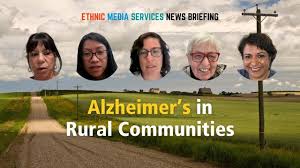Vidya Sethuraman
India Post News Service
As more people live longer lives, more Californians will face living with Alzheimer’s disease than ever. The number of people living with Alzheimer’s disease and related dementias (ADRDs) is projected to double over the next 20 years.
Californians living in rural and remote regions face additional challenges in accessing preventative, screening, diagnostic, and caregiving services, healthcare providers, and resources compared to Californians living in urban communities.
There are long wait times to see ADRD specialists that can provide a diagnosis. Lack of public transportation means longer commute times to access these critical healthcare services and resources. This can impact not only the person experiencing signs of Alzheimer’s, but their families as well.
In the EMS Briefing on June 13, Alzheimer’s healthcare providers, researchers, and advocates discussed how they’re working to address these disparities in access and meet the needs of California’s underserved, rural communities as its population ages and grows.
Dr. Rita Nguyen, Assistant Health Officer for the State of California and Director of Population Health, California Department of Public Health said that residents in rural communities face the most severe challenges in accessing medical resources.
Patients and families face longer waits and commute times due to specialist shortages and lack of transportation. She called on the community to raise awareness of Alzheimer’s disease and, to enable early detection and diagnosis, so that patients and their families can receive the support and care they need. She specifically mentioned that a healthy lifestyle, including healthy eating, staying active, social connections and good sleep, is crucial to preventing Alzheimer’s disease and other related diseases.
Carmen Estrada, Executive Director, Inland Caregiver Resource Center said that the remote areas of California served by the center are culturally diverse and medical resources are unevenly distributed. Service providers must have a deep understanding of the unique needs of each community and develop practical solutions. In order to reach more rural dementia patients and their families, the center adopts a variety of innovative service methods, such as telephone consultation, video consultation, door-to-door services, etc.; it also focuses on developing culturally appropriate service projects, such as launching end-of-life services for the Latino community.
Hagar Dickman, Senior Attorney, Justice in Aging that medical resources are extremely scarce in rural areas, especially for Alzheimer’s patients who are unable to manage their own care. She pointed out that due to a lack of medical services and transportation, these patients often have to spend their later years at home or in the hospital, and even face the risk of early death.
She explained that the largest personal care service program in California is the In-Home Supportive Services (IHSS) program. The IHSS program and other similar programs also have very limited coverage and accessibility in rural areas. She suggested that policies should change to better support these vulnerable groups, including increasing resources and providing more intensive case management services.
The California Department of Public Health has launched a statewide campaign called “Take on Alzheimer’s” to increase education and raise awareness about the disease. This is an education and awareness campaign aimed toward all Californians to promote healthy brains, knowledge about the difference between aging and dementia, and improve conversations with loved ones and health care providers.







